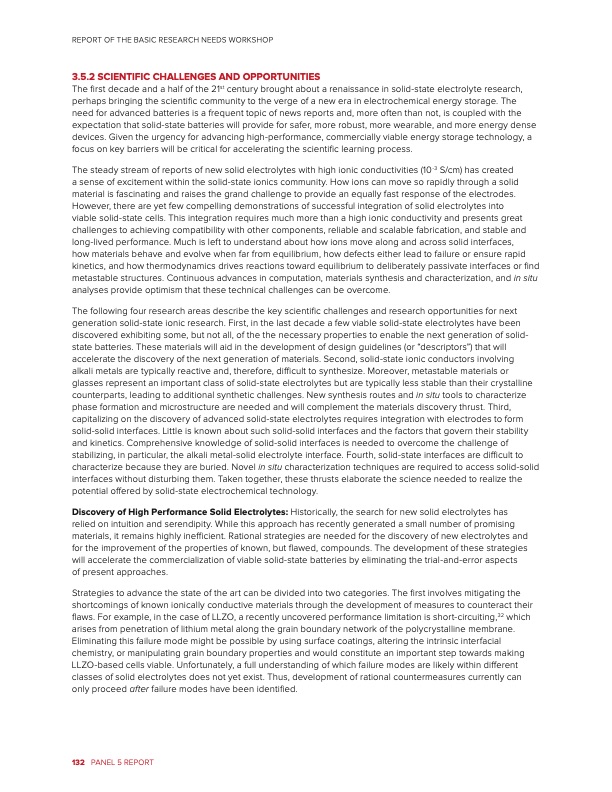
PDF Publication Title:
Text from PDF Page: 138
REPORT OF THE BASIC RESEARCH NEEDS WORKSHOP 3.5.2 SCIENTIFIC CHALLENGES AND OPPORTUNITIES The first decade and a half of the 21st century brought about a renaissance in solid-state electrolyte research, perhaps bringing the scientific community to the verge of a new era in electrochemical energy storage. The need for advanced batteries is a frequent topic of news reports and, more often than not, is coupled with the expectation that solid-state batteries will provide for safer, more robust, more wearable, and more energy dense devices. Given the urgency for advancing high-performance, commercially viable energy storage technology, a focus on key barriers will be critical for accelerating the scientific learning process. The steady stream of reports of new solid electrolytes with high ionic conductivities (10-3 S/cm) has created a sense of excitement within the solid-state ionics community. How ions can move so rapidly through a solid material is fascinating and raises the grand challenge to provide an equally fast response of the electrodes. However, there are yet few compelling demonstrations of successful integration of solid electrolytes into viable solid-state cells. This integration requires much more than a high ionic conductivity and presents great challenges to achieving compatibility with other components, reliable and scalable fabrication, and stable and long-lived performance. Much is left to understand about how ions move along and across solid interfaces, how materials behave and evolve when far from equilibrium, how defects either lead to failure or ensure rapid kinetics, and how thermodynamics drives reactions toward equilibrium to deliberately passivate interfaces or find metastable structures. Continuous advances in computation, materials synthesis and characterization, and in situ analyses provide optimism that these technical challenges can be overcome. The following four research areas describe the key scientific challenges and research opportunities for next generation solid-state ionic research. First, in the last decade a few viable solid-state electrolytes have been discovered exhibiting some, but not all, of the the necessary properties to enable the next generation of solid- state batteries. These materials will aid in the development of design guidelines (or “descriptors”) that will accelerate the discovery of the next generation of materials. Second, solid-state ionic conductors involving alkali metals are typically reactive and, therefore, difficult to synthesize. Moreover, metastable materials or glasses represent an important class of solid-state electrolytes but are typically less stable than their crystalline counterparts, leading to additional synthetic challenges. New synthesis routes and in situ tools to characterize phase formation and microstructure are needed and will complement the materials discovery thrust. Third, capitalizing on the discovery of advanced solid-state electrolytes requires integration with electrodes to form solid-solid interfaces. Little is known about such solid-solid interfaces and the factors that govern their stability and kinetics. Comprehensive knowledge of solid-solid interfaces is needed to overcome the challenge of stabilizing, in particular, the alkali metal-solid electrolyte interface. Fourth, solid-state interfaces are difficult to characterize because they are buried. Novel in situ characterization techniques are required to access solid-solid interfaces without disturbing them. Taken together, these thrusts elaborate the science needed to realize the potential offered by solid-state electrochemical technology. Discovery of High Performance Solid Electrolytes: Historically, the search for new solid electrolytes has relied on intuition and serendipity. While this approach has recently generated a small number of promising materials, it remains highly inefficient. Rational strategies are needed for the discovery of new electrolytes and for the improvement of the properties of known, but flawed, compounds. The development of these strategies will accelerate the commercialization of viable solid-state batteries by eliminating the trial-and-error aspects of present approaches. Strategies to advance the state of the art can be divided into two categories. The first involves mitigating the shortcomings of known ionically conductive materials through the development of measures to counteract their flaws. For example, in the case of LLZO, a recently uncovered performance limitation is short-circuiting,32 which arises from penetration of lithium metal along the grain boundary network of the polycrystalline membrane. Eliminating this failure mode might be possible by using surface coatings, altering the intrinsic interfacial chemistry, or manipulating grain boundary properties and would constitute an important step towards making LLZO-based cells viable. Unfortunately, a full understanding of which failure modes are likely within different classes of solid electrolytes does not yet exist. Thus, development of rational countermeasures currently can only proceed after failure modes have been identified. 132 PANEL 5 REPORTPDF Image | Next Generation Electrical Energy Storage

PDF Search Title:
Next Generation Electrical Energy StorageOriginal File Name Searched:
BRN-NGEES_rpt-low-res.pdfDIY PDF Search: Google It | Yahoo | Bing
Sulfur Deposition on Carbon Nanofibers using Supercritical CO2 Sulfur Deposition on Carbon Nanofibers using Supercritical CO2. Gamma sulfur also known as mother of pearl sulfur and nacreous sulfur... More Info
CO2 Organic Rankine Cycle Experimenter Platform The supercritical CO2 phase change system is both a heat pump and organic rankine cycle which can be used for those purposes and as a supercritical extractor for advanced subcritical and supercritical extraction technology. Uses include producing nanoparticles, precious metal CO2 extraction, lithium battery recycling, and other applications... More Info
| CONTACT TEL: 608-238-6001 Email: greg@infinityturbine.com | RSS | AMP |